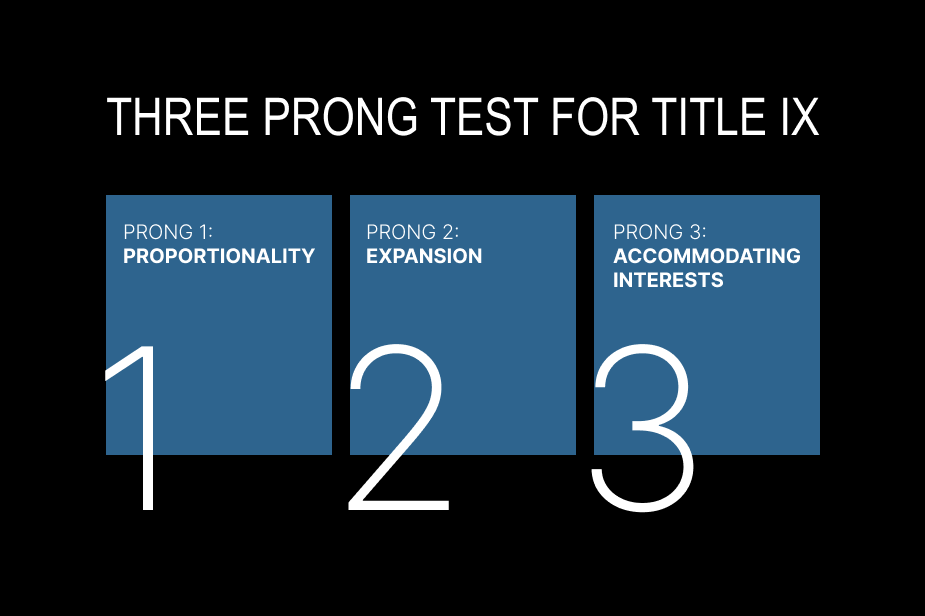Title IX of the Education Amendments of 1972 is a federal law that prohibits discrimination on the basis of sex from all aspects in any federally funded education program or activity. One of these aspects is the equal athletic opportunities for male and female students which is ensured by implementing a “three-prong” test. This test is used to determine if a school has effectively accommodated the athletic interests of both genders.
It’s worth noting that, according to the National Women’s Law Center, after Title IX law was passed in 1972, women’s and girls’ participation in sports has remarkably increased. Before Title IX, women in college sports made up less than 16 percent of all college athletes. This percentage grew to 44 percent by the 2019-20 period. Similarly, in high schools, the participation of girls in sports was only 7 percent in 1972, which increased to 43 percent by the 2018-19 school year.
Three Components of Title IX
Before diving into the three-prong test, it’s essential to understand the three components of Title IX‘s requirements for school athletics programs. These components are as follows:
Accommodating Student Interests
Schools must effectively accommodate the athletic interests of both male and female students by providing opportunities for participation in sports that align with their individual preferences and abilities. This involves conducting surveys, engaging in dialogue, and monitoring participation trends to gain insights into the sports preferences of students. By understanding their interests, schools can design athletic programs that cater to a diverse range of sports options and create an inclusive environment where students feel encouraged and supported to pursue their chosen sports.
Proportional Financial Assistance
Schools are required to provide proportional financial assistance to male and female teams, ensuring equitable support for both genders. This means allocating financial resources in a manner that reflects the proportionate representation of male and female athletes. By distributing financial aid, scholarships, and funding for equipment and travel in a proportional manner, schools can ensure that both male and female teams have the necessary resources to succeed and compete at a comparable level, promoting fairness and equal opportunities in athletics.
Equal Benefits and Opportunities
To promote gender equity in athletics, schools must offer equal benefits and opportunities to teams for both genders. This includes providing comparable access to facilities, coaching, uniforms, equipment, scheduling, officials, sports options, and competition levels. By ensuring that both male and female athletes have access to the same quality and quantity of resources and opportunities, schools create an environment that fosters fair competition, personal growth, and satisfaction for all athletes, regardless of gender. Additionally, offering a diverse range of sports options encourages students to explore their interests and talents, promoting inclusivity and a sense of belonging within the athletic program.
Now, let’s explore the three-prong test in detail.
Three-Prong Test for Title IX
The three-prong test is a set of criteria used to determine whether a school is effectively providing equivalent opportunities for males and females students in athletics, as required by Title IX. Following are the three prongs for Title IX:
- Prong 1: Proportionality
- Prong 2: Expansion
- Prong 3: Accommodating Interests
Each prong represents a different approach to compliance, and meeting any one of the three prongs is sufficient to satisfy Title IX requirements.
Prong 1: Proportionality
The first prong of the three-prong test examines the proportionality of male and female student participation in a school’s athletics program. Specifically, it evaluates whether the number of male and female student-athletes is proportional to the overall male and female student enrollment in the institution. If the proportion of female student-athletes is significantly lower than the proportion of female students in the school, this prong is not satisfied.
To determine proportionality, schools typically calculate it using both “unduplicated” and “duplicated” measures. The unduplicated measure counts student-athletes once, regardless of their participation in multiple sports, while the duplicated measure accounts for multiple-sport athletes to reflect the actual number of participation slots available. Typically, a difference of less than five percent between the proportion of female athletes and female enrollment is considered within the “safe harbor” of proportionality.
Prong 2: Expansion
If a school fails to satisfy the first prong, it may still comply with Title IX by meeting the requirements of the second prong, which focuses on program expansion. The school must demonstrate a history and continuing practice of expanding athletic opportunities for female students to align with their interests.
By actively working toward proportional representation in its athletics program, even if it hasn’t achieved it yet, the school can fulfill Title IX requirements. This prong considers the efforts made by the school in recent years to add participation opportunities for female students. It is important to note that schools cannot eliminate or downsize sports programs for girls while claiming compliance with the second prong.
Prong 3: Accommodating Interests
The third prong of the three-prong test allows schools with disproportionate athletics programs, which are not currently expanding, to comply with Title IX by demonstrating that their existing program adequately accommodates the interests of female students. In other words, if a school can show that there is no additional interest from female students to participate in an expanded athletic program, it can be considered in compliance with Title IX.
To prove full and effective accommodation, schools may conduct surveys and evaluate other indicators of interest, such as participation rates at the middle school, youth, and recreational league levels. The aim is to determine whether all the athletic interests of female students are being sufficiently addressed.
A Court Case Example: Ollier v. Sweetwater Union School District
One notable court case that exemplifies the application of the three-prong test is Ollier v. Sweetwater Union School District. The dispute, which originated in 2006, centered around facility inequities between softball and baseball at Castle Park High School in California. The case underwent a Title IX investigation by the Office for Civil Rights (OCR) and later led to a federal court proceeding.
In a 2009 decision by the U.S. District Court for the Southern District of California, the judge referenced data that had been collected to assess compliance with Component I of the Title IX Compliance Framework. Female enrollment at the school was found to be 45.4 percent, while only 38.7 percent of sports participation opportunities belonged to girls, according to the duplicated measure of proportionality. This resulted in a 6.7 percent difference, indicating a failure to meet the first prong of the three-prong test.
Additionally, the school was unable to demonstrate compliance with the second prong, which required a history and ongoing pattern of program expansion to provide equal athletic opportunities for girls. It’s important to note that schools cannot claim compliance with the second prong if they are in the process of downsizing or eliminating sports for girls.
Consequently, the school had to rely on the third prong of the three-prong test. To fulfill this prong, the school needed to show that it fully and effectively accommodated the athletic interests and abilities of the female students enrolled. This involved proving that the school had maximized its sports offerings for girls and that there were no additional sports in which there was sufficient interest among female students to field a team. Surveys and other indicators were utilized to assess the satisfaction of all the athletic interests of female students.
This court case demonstrates how the three-prong test was applied to evaluate compliance with Title IX. It highlights the importance of meeting at least one prong to demonstrate compliance and avoid sex-based discrimination in athletics programs. By thoroughly assessing the participation opportunities, financial aid distribution, and other benefits and opportunities available to female students, schools can ensure compliance with Title IX and promote equal access and treatment in sports.
If you’re experiencing gender-based discrimination in your school’s athletic program, contact K Altman Law to get legal assistance from an experienced Title IX lawyer.
Criticisms and Issues with the Three-Prong Test
While the three-prong test has served as a framework for Title IX compliance, it has faced criticism and raised concerns in certain areas as below:
- Quota System Criticism
- Limited Application Beyond Athletics
- Reduction in Men’s Programs
- Increasing Cost of Compliance
Quota System Criticism
Some argue that the test resembles a quota system, which may not accurately reflect the interests and abilities of students or provide flexibility for schools.
The three-prong test has faced criticism for resembling a quota system. Critics argue that relying on specific numerical thresholds to assess compliance may not accurately reflect the interests and abilities of students. They contend that the test’s focus on proportional representation might overlook individual preferences and capabilities, potentially leading to unfair outcomes.
Additionally, the test’s rigid nature raises concerns about the lack of flexibility for schools. Opponents argue that schools should have more autonomy in designing their athletic programs based on the unique needs and interests of their students. A strict adherence to the three-prong test may limit schools’ ability to respond to changing circumstances and adequately address the diverse interests of their student body.
Limited Application Beyond Athletics
The three-prong test primarily focuses on athletics and may not adequately address other areas of sex-based discrimination in education covered by Title IX. While the three-prong test has been effective in assessing compliance in athletics programs, some critics argue that it has limited application and may not fully address other areas of sex-based discrimination covered by Title IX. Title IX extends beyond athletics to areas such as:
- Recruitment and admissions
- Financial aid
- Discipline
- Counseling programs
- Treatment of pregnant or parenting students
By primarily focusing on athletics, the three-prong test may not sufficiently capture and address disparities in these other important areas. Critics emphasize the need for a comprehensive approach to Title IX compliance that extends beyond athletics and considers the broader scope of sex-based discrimination in education.
Reduction in Men’s Programs
Critics claim that compliance efforts sometimes lead to the elimination or reduction of men’s athletic programs, raising concerns about potential gender imbalances and restricted opportunities for male students.
One common criticism of the three-prong test is that compliance efforts aimed at expanding opportunities for female athletes can inadvertently result in the elimination or reduction of men’s athletic programs. Some argue that in the pursuit of proportional representation, schools may face pressure to reduce opportunities for male students to ensure gender balance.
This concern stems from the belief that the three-prong test may create a zero-sum game, where gains for one gender come at the expense of the other. Critics worry that such reductions may result in limited athletic opportunities for male students, potentially leading to gender imbalances and restricted options for male athletes.
Administrative Burdens and Costs
Schools and institutions have raised issues regarding the administrative burden, costs, and complexities associated with implementing and maintaining compliance with the three-prong test.Implementing and maintaining compliance with the three-prong test can pose significant challenges for schools and institutions. Meeting the requirements of the test often requires extensive data collection, analysis, and reporting, which can place a substantial administrative burden on educational institutions.
Moreover, ensuring compliance may involve financial costs, such as funding additional sports programs, expanding facilities, and providing resources for coaching, equipment, and uniforms. Schools may face challenges in allocating resources effectively to accommodate student interests while adhering to limited budgets.
Flexibility of the Three-Prong Test
Despite its criticisms, the three-prong test allows for flexibility in assessing Title IX compliance. Schools have the option to satisfy any one of the three prongs, providing an opportunity to tailor their approach based on their specific circumstances and student interests.
This flexibility recognizes that every educational institution is unique, with varying resources, demographics, and student preferences. By allowing schools to meet at least one prong, the test acknowledges that different schools may adopt different strategies to accommodate their student populations effectively.
For instance, a school with a higher proportion of female students may choose to focus on expanding athletic opportunities under the second prong, demonstrating a commitment to equalizing representation. Conversely, a school with limited resources or unique student interests may prioritize demonstrating full and effective accommodation under the third prong.
By allowing schools to choose the approach that aligns best with their specific circumstances, the three-prong test encourages innovation and flexibility in achieving Title IX compliance. It ensures that schools can adapt their strategies to meet the needs of their students while upholding the principles of gender equity in athletics.
Equal Access and Treatment in Athletics
Title IX’s overarching goal is to ensure equal access and treatment in athletics for both male and female students. By complying with Title IX, schools can foster an environment that promotes gender equality, opportunities, and fairness in sports.
Equal access means that male and female students should have an equal opportunity to participate in athletics. It encompasses providing equal access to tryouts, team selection, and opportunities for skill development. Schools must ensure that no student is excluded from participating in sports on the basis of their gender.
Equal treatment requires that male and female students receive equitable treatment within the athletics program. This includes equitable distribution of resources, such as coaching, facilities, uniforms, equipment, scheduling, and officials. It also encompasses offering comparable levels of competition and maintaining similar standards of quality across teams.
By upholding equal access and treatment, schools create an inclusive and supportive environment where students can pursue their athletic interests without being subjected to gender-based discrimination or biases. This not only promotes gender equity but also provides valuable life skills, leadership opportunities, and physical and mental well-being for all students.
Compliance with Title IX
To achieve compliance with Title IX, schools must adhere to the three components mentioned earlier, accommodating student interests, proportional financial assistance, and equal benefits and opportunities. By meeting these requirements and satisfying any one of the three prongs in the three-prong test, schools can demonstrate their commitment to Title IX compliance.
Compliance with Title IX involves an ongoing commitment to assessing and addressing gender equity in athletics. Schools should regularly review their programs, policies, and practices to ensure they align with the principles of Title IX. This may involve following:
- Conducting surveys
- Gathering data
- Engaging in dialogue with students, parents, and the wider community
Schools should establish clear procedures and mechanisms for addressing Title IX complaints or concerns related to Title IX violations promptly. They should also provide education and training to staff, coaches, and students to raise awareness about Title IX requirements and foster a culture of gender equity and respect within the athletics program.
By proactively engaging in compliance efforts, schools demonstrate their dedication to creating an inclusive and equitable environment that empowers all students to participate in athletics without discrimination.
Considerations for Compliance with Title IX
When striving for Title IX compliance, schools should consider the following factors:
Conduct surveys and evaluate interest indicators
Schools should gather data on the athletic interests of their students, particularly female students. This information can help identify areas where additional opportunities may be needed to accommodate student interests effectively.
Strive for proportional representation
Schools should work towards expanding athletic opportunities for underrepresented genders to achieve a proportional balance. This may involve adding sports programs or ensuring that existing programs cater to the interests of all students.
Ensure financial assistance is proportionally provided
Schools must allocate financial resources in a manner that provides proportional support to both male and female teams. This includes scholarships, grants, and funding for equipment, travel, and other related expenses.
Offer equal benefits and opportunities
Schools should provide equal access to facilities, coaching, uniforms, equipment, scheduling, officials, and a diverse range of sports options for both male and female teams. It is crucial to ensure that the quality and quantity of resources and opportunities are equitable across genders.
By considering these factors and implementing strategies that address them, schools can make significant progress towards achieving Title IX compliance and fostering a more inclusive and equitable athletic program.
Conclusion
The three-prong test plays a vital role in assessing Title IX compliance in schools’ athletics programs. By meeting the requirements of accommodating student interests, proportional financial assistance, and equal benefits and opportunities, schools can create an inclusive and equitable athletic environment for all students, promoting gender equality and providing fair opportunities for both male and female athletes.
If you’re confronting sex-based discrimination in your school, remember that Title IX is there to ensure your rights are protected. For legal help and representation in sex-based discrimination issues, call K Altman Law at 888-984-1341. Our experienced team can help you understand your rights under Title IX and work towards ensuring compliance and fair treatment in your school.






